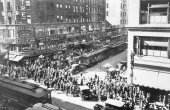Do We Really Want Our Mayors to Have a Vision?

An unfortunate trend has developed over the past quarter-century: Many municipalities have begun describing their development plans as a “vision,” a word once reserved for spiritual gurus and artists. Calling a simple municipal action and investment program — such as collecting tolls on bridges — a “vision” is symptomatic of the grandiose misunderstanding that municipalities have concerning their role. A city, after all, is entirely created by its citizens’ initiatives. These citizens are required to act within a set of “good neighbor” rules, and to be supported in their endeavors by a network of physical and social infrastructure managed by a mayor and a city council. Mayors and their municipal staff, including urban planners and economists, should be considered not visionaries or rulers, then, but a well-coordinated team (one hopes) of competent managers and janitors.

You might be thinking, “Does it really matter if mayors use the word ‘vision’ to describe their programs?” I think it does. As George Orwell wrote in his prescient 1946 essay “Politics and the English Language,” “[I]f thought corrupts language, language can also corrupt thought.”
A mayor convinced of the necessity of having a vision to manage a city would feel less inclined to respond in a supportive way to the changes brought by the activities and innovations of the city’s population. A visionary mayor may feel compelled to impose her unique insights on the life of her Philistine citizens. A mayor with a vision needs to be followed, not questioned by people who lack one. Visionary leadership implies a top-down approach, in other words, but a city is mostly created from the bottom up.
A visionary mayor may feel compelled to impose her unique insights on the life of her Philistine citizens.
Take, for example, Bill de Blasio, the mayor of New York City. “Look,” he told New York Magazine in 2017, “if I had my druthers, the city government would determine on every single plot of land, how development would proceed. And there would be very stringent requirements around income levels and rents. That’s a world I’d love to see.”
Meanwhile, garbage in plastic bags encumber the sidewalks at night in New York City and the transport system is literally crumbling.
To be sure, a top-down approach is required to design infrastructure and services, but only as they are needed to support citizens’ activities. The support role involved in this top-down design is not trivial and requires good data and outstanding technical and financial skills, but a personal vision is not a requirement. It might rather be a hindrance.
For an example of a region built from the bottom up, we can look no further than Silicon Valley, arguably the most innovative urban concentration to emerge in the past half-century. The creation of Silicon Valley is a perfect example of the advantages of a grassroots citizens’ vision, as opposed to a top-down mayoral vision. It was not created by a visionary mayor but by a large group of brilliant tinkerers, at times collaborating, but certainly not coordinating, their actions by implementing a common plan. The tinkerers had visions. Hewlett Packard and Apple were started in garages, in violation of local zoning laws! The deans and provosts of Stanford University had vision, as they encouraged their students and researchers to start their own enterprises, and provided start-up incubator workspaces on land belonging to the university. But no visionary mayors or urban planners were involved in the creation of Silicon Valley.
The fragmentation of municipal power — Silicon Valley extends over about 18 municipalities — prevented planners from creating a special zone where anybody dealing with electronics would have to operate. One shudders at the thought that the municipal planners in Silicon Valley could have circumscribed the coders to a special coder zone, like the one reserved for artists created in New York in 1969.
It was there that the New York City Planning Commission created M1-5A, a zoning category that specified that only artists could live in the NoHo area that was zoned for manufacturing — one of the most extreme cases of a zoning micromanagement rule I have ever seen. The new category, which still exists today, only grants residence to “fine artists working on a professional level” who can “demonstrate a need for a live/work loft.” The resolution further specifies that an artist is “a person so certified by The New York City Department of Cultural Affairs.”
Given the complex housing affordability problems faced by New York City, with around 60,000 homeless people living in shelters, it is astonishing to learn that municipal employees spend time looking at artists’ portfolios to decide whether they deserve to be able to rent a loft.
Given the complex housing affordability problems faced by New York City, with around 60,000 homeless people living in shelters, it is astonishing to learn that municipal employees spend time looking at artists’ portfolios.
The planners of the various Silicon Valley municipalities deserve credit, then, for not having killed through land use regulations the activities of the emerging electronics industry. This industry, with its mix of coding, venture finance, and light manufacturing did not readily fit any traditional zoning district description.
I have worked in a few cities where “visionary planners” pretended to include the design of new “Silicon Valley” satellite towns in their Master Plans. These visions never took off. By contrast, where some of Silicon Valley conditions are met — a great university next to open land with flexible land use — similar creative activities may emerge. This has been the case in Beijing, for instance, in the area located between Peking University and Tsinghua University, and in some areas of the Pearl River Delta in southern China.
Indeed, Silicon Valley’s success depended on the municipal management teams being able to adjust to changing demand for urban services and infrastructure that were required by the sudden transformation of the area, originally largely residential, to a new type of land use. It was not driven by a top-down “vision” but involved great professionalism in many sectors, including land use and traffic management, transport, infrastructure building and maintenance, education, refuse disposal, security, taxation, and tariffs. They did not need vision, but something much less romantic: extreme competence.
Alain Bertaud is Senior Research Scholar at New York University’s Marron Institute of Urban Management, and the author of “Order without Design,” from which this article was adapted. He has worked as Principal Urban Planner for the World Bank and as an independent consultant and resident urban planner in cities ranging from Bangkok to New York.



